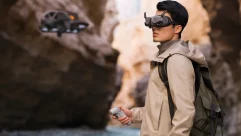From novel toys to valuable tools, drones have swiftly evolved to lift our view skyward, search for looming trouble in inaccessible places, chase criminals, and even save lives. Technology never waits on the law and it has been interesting to watch state and federal regulations try to keep up, often colliding more than the vehicles themselves. Payload sensing, multi-pilot operation, completely autonomous missions, and an ongoing variety of other tech innovations allow these machines to cruise on their revolutionary way.
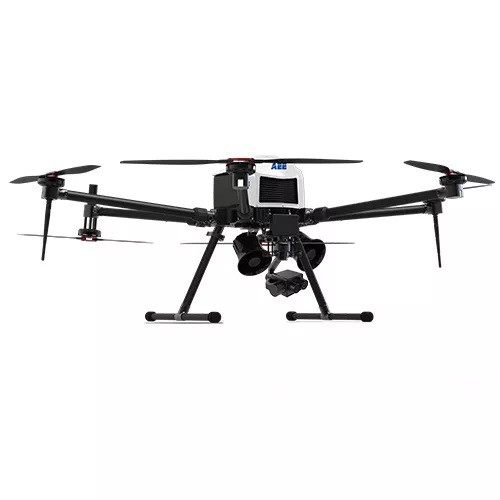 Capable of day or night operation and equipped to carry a huge variety of payloads, the AEE Aviation Technology Mach 6 has dual RTK antennas for highly accurate positioning. The vehicle lifts a payload up to 13lbs. and it can switch to AEE Night Color and thermal tracking. It can also carry a DAR1 spotlight and a Thunderhorn megaphone system. This drone is designed to carry as many as three payloads simultaneously. If there is a motor glitch, the Mach 6 can still perform even with one engine out. Up to 50-minute flight times are possible with a flight range of up to seven miles. The DATB Highzoom camera payload has 1080p/60 RGB resolution, a 10x optical zoom, fast zoom/focus, and a 3D gimbal for stable imaging. The EHOOK accessory is a remote drop system with a fast connect Smart ACCY Shoe (SAS).
Capable of day or night operation and equipped to carry a huge variety of payloads, the AEE Aviation Technology Mach 6 has dual RTK antennas for highly accurate positioning. The vehicle lifts a payload up to 13lbs. and it can switch to AEE Night Color and thermal tracking. It can also carry a DAR1 spotlight and a Thunderhorn megaphone system. This drone is designed to carry as many as three payloads simultaneously. If there is a motor glitch, the Mach 6 can still perform even with one engine out. Up to 50-minute flight times are possible with a flight range of up to seven miles. The DATB Highzoom camera payload has 1080p/60 RGB resolution, a 10x optical zoom, fast zoom/focus, and a 3D gimbal for stable imaging. The EHOOK accessory is a remote drop system with a fast connect Smart ACCY Shoe (SAS).
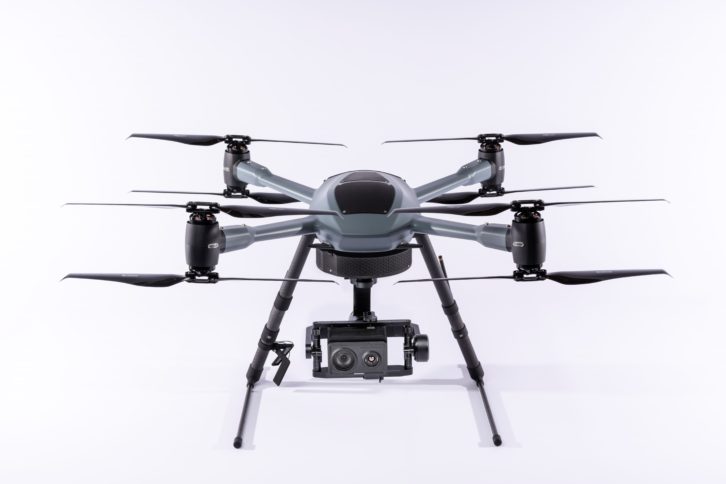 A proven performer in payload versatility, lifting capacity, flight control sophistication, and camera selection, the Aerialtronics Altura Zenith works with tablet control to configure complex flight plans and enable full payload and camera control from the ground. The compact and lightweight carbon fiber design can stand up to frequent use and the IPX 5 TüV rating allows it to fly in light rain or snow for up to 40 minutes. This model has a maximum flight range of over 11 miles and can handle wind speeds as high as 35 miles per hour. There are four pairs of 16in. propellers and the quick release battery tray can make 22.2V battery swapping a breeze. According to Altura, their motors have flown up to 720 hours without fault and pre-programmed switches allow the pilot to shift between flight-modes.
A proven performer in payload versatility, lifting capacity, flight control sophistication, and camera selection, the Aerialtronics Altura Zenith works with tablet control to configure complex flight plans and enable full payload and camera control from the ground. The compact and lightweight carbon fiber design can stand up to frequent use and the IPX 5 TüV rating allows it to fly in light rain or snow for up to 40 minutes. This model has a maximum flight range of over 11 miles and can handle wind speeds as high as 35 miles per hour. There are four pairs of 16in. propellers and the quick release battery tray can make 22.2V battery swapping a breeze. According to Altura, their motors have flown up to 720 hours without fault and pre-programmed switches allow the pilot to shift between flight-modes.
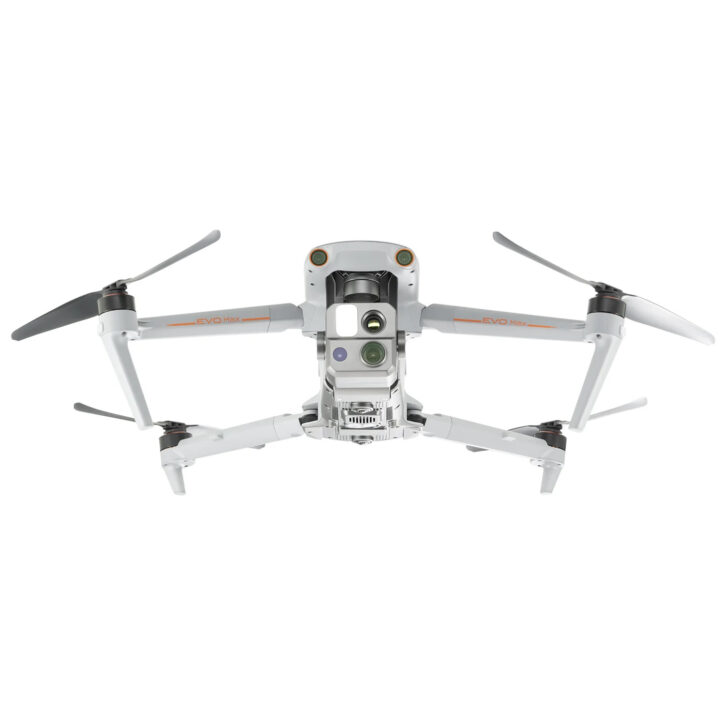 Once the battery is quickly installed, the Autel Robotics Evo Max 4T and its controller can be unfolded and set up in minutes. The vehicle can take to the air in auto mode with a push-button takeoff or in a manual mode using the controller’s twin joysticks. Weighing in at just three and a half pounds, the craft is easy to carry and leaps into the air at up to 23ft. per second vertical speed. Then it can zoom along horizontally at 75 miles per hour and its IP43 rating allows it to deal with hostile weather elements and frequent use. The Evo Max series drones typically have 720-degree obstacle avoidance, navigation in GPS-denied areas, 0.0001 LUX Starlight cameras, hot swappable batteries, 12.4-mile transmission range, and 42 minutes maximum flight time.
Once the battery is quickly installed, the Autel Robotics Evo Max 4T and its controller can be unfolded and set up in minutes. The vehicle can take to the air in auto mode with a push-button takeoff or in a manual mode using the controller’s twin joysticks. Weighing in at just three and a half pounds, the craft is easy to carry and leaps into the air at up to 23ft. per second vertical speed. Then it can zoom along horizontally at 75 miles per hour and its IP43 rating allows it to deal with hostile weather elements and frequent use. The Evo Max series drones typically have 720-degree obstacle avoidance, navigation in GPS-denied areas, 0.0001 LUX Starlight cameras, hot swappable batteries, 12.4-mile transmission range, and 42 minutes maximum flight time.
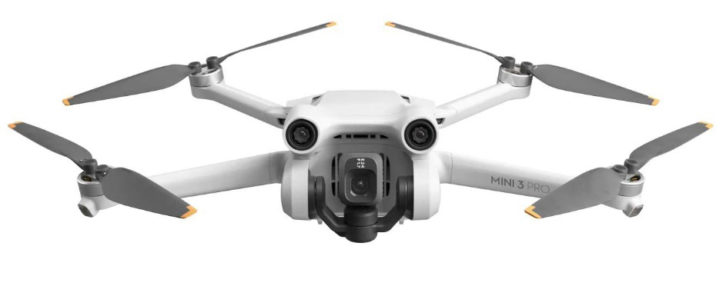 Serving as an example of how the company has remained a leader in drone technology and deployment, the DJI Mini 3 Pro carries a 4/3 CMOS 20 megapixel Hasselblad Camera along with dual tele cameras and it can transmit their HD images nearly ten miles. To switch between focal lengths, the operator simply taps the controller display. The new 10-bit D-Log M color mode allows recording of up to one billion colors. Its upgraded tele camera shoots 4K/60fps video through a 7x optical zoom and it takes 12-megapixel photographs. All-direction object avoidance is driven by eight wide-angle vision sensors. Nocturnal assistance provides the capability to see dimly lit obstacles as bright spots to assist the operator at night while the signal transmitter conveys 1080p/60fps video. The system can automatically plan a flight based on the user’s waypoints.
Serving as an example of how the company has remained a leader in drone technology and deployment, the DJI Mini 3 Pro carries a 4/3 CMOS 20 megapixel Hasselblad Camera along with dual tele cameras and it can transmit their HD images nearly ten miles. To switch between focal lengths, the operator simply taps the controller display. The new 10-bit D-Log M color mode allows recording of up to one billion colors. Its upgraded tele camera shoots 4K/60fps video through a 7x optical zoom and it takes 12-megapixel photographs. All-direction object avoidance is driven by eight wide-angle vision sensors. Nocturnal assistance provides the capability to see dimly lit obstacles as bright spots to assist the operator at night while the signal transmitter conveys 1080p/60fps video. The system can automatically plan a flight based on the user’s waypoints.
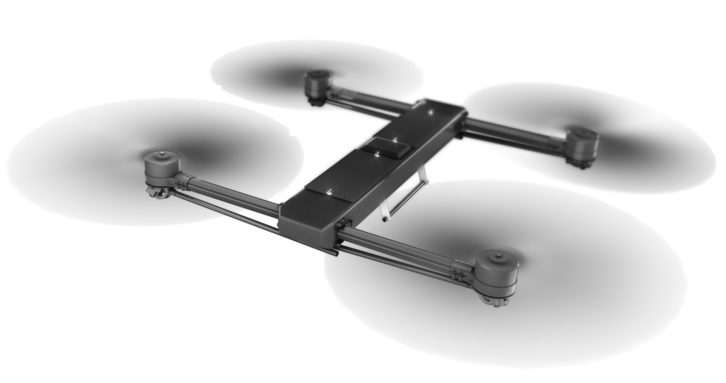 The company calls its product the Swiss Army knife of drones and the Draganfly Innovations Commander 3 XL has earned that billing with speeds of nearly 45 miles per hour, 24-mile flight range, and 50-minute maximum flight time. Equally capable in manual or automated flight modes, the craft has two quick-release arm assemblies that fit into each end of the simple rectangular tube fuselage. For automatic connection during assembly, the batteries are semi-permanently attached to carrier plates. This model can carry up to 22lbs. for as long as 20 minutes. Configurations for radio control include point-to-point and cellular link. A new version with a 3-hour flight time, the Commander 3 XL Hybrid, was just unveiled at the Commercial UAV Expo in Las Vegas in September. Both models feature Draganfly’s Precision Delivery System.
The company calls its product the Swiss Army knife of drones and the Draganfly Innovations Commander 3 XL has earned that billing with speeds of nearly 45 miles per hour, 24-mile flight range, and 50-minute maximum flight time. Equally capable in manual or automated flight modes, the craft has two quick-release arm assemblies that fit into each end of the simple rectangular tube fuselage. For automatic connection during assembly, the batteries are semi-permanently attached to carrier plates. This model can carry up to 22lbs. for as long as 20 minutes. Configurations for radio control include point-to-point and cellular link. A new version with a 3-hour flight time, the Commander 3 XL Hybrid, was just unveiled at the Commercial UAV Expo in Las Vegas in September. Both models feature Draganfly’s Precision Delivery System.
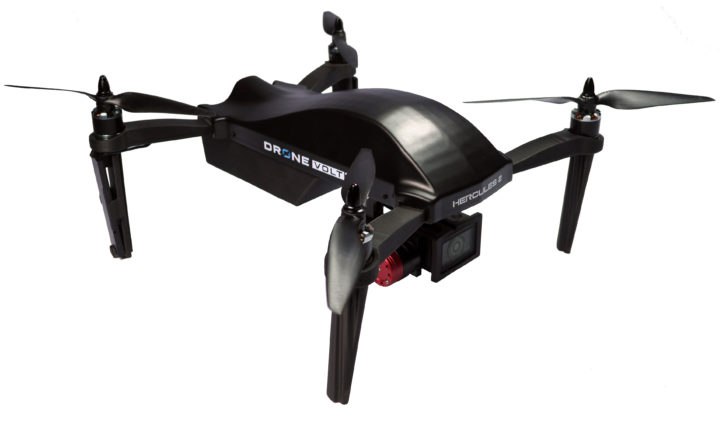 Only 14in. square and transportable in a back-pack, the Drone Volt Hercules 2 is small enough to be a toy but completely pro level in its capabilities. It weighs barely four pounds and the vehicle has self-locking propellers, requires no assembly and zips along at up to 55 miles per hour with its data encrypted through AES 256. The system includes drone and camera control with automated mission programming. Users don’t have to baby this craft with its Multi Jet Fusion and nylon reinforced structure. The Hercules 2 can fly for 14 minutes and transmit its signal more than a mile. The compact Viewpro Q10F camera has a 4MP 1/3 CMOS sensor that enables HD video recording while its 10x optical zoom gets very close-up views.
Only 14in. square and transportable in a back-pack, the Drone Volt Hercules 2 is small enough to be a toy but completely pro level in its capabilities. It weighs barely four pounds and the vehicle has self-locking propellers, requires no assembly and zips along at up to 55 miles per hour with its data encrypted through AES 256. The system includes drone and camera control with automated mission programming. Users don’t have to baby this craft with its Multi Jet Fusion and nylon reinforced structure. The Hercules 2 can fly for 14 minutes and transmit its signal more than a mile. The compact Viewpro Q10F camera has a 4MP 1/3 CMOS sensor that enables HD video recording while its 10x optical zoom gets very close-up views.
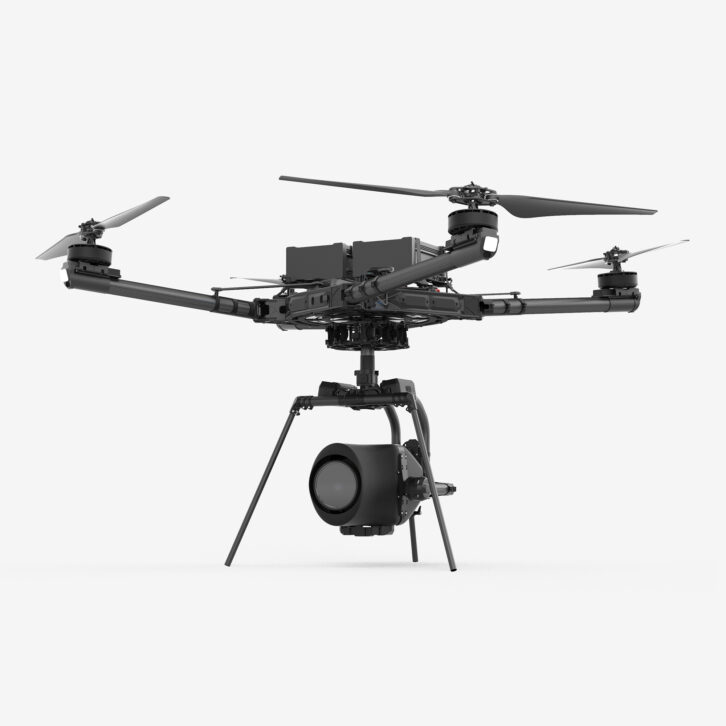 At the other end of the size and muscle range, the FreeFly Alta X can take a 22lb. payload up on a 22-minute flight or carry the 100 Megapixel Phase One 8lb. mapping camera for 25 minutes. With a 5lb. load it can stay aloft for over 41 minutes. The Alta ActiveBlade propeller design reduces vibration, thereby extending the life of the structure and a hallmark of the company is after-sale support with spare parts and maintenance. Another possible payload is a cinema grade LED lighting instrument. Among the variety of ports, there are three battery voltage power ports with fused outputs for payload power, a MAVLINK UART for accessories, and a USB-C port for firmware updates. FreeFly can also equip the Alta X for centimeter-level precision by adding their multi-band RTK system. The company also provides on-site pilot training.
At the other end of the size and muscle range, the FreeFly Alta X can take a 22lb. payload up on a 22-minute flight or carry the 100 Megapixel Phase One 8lb. mapping camera for 25 minutes. With a 5lb. load it can stay aloft for over 41 minutes. The Alta ActiveBlade propeller design reduces vibration, thereby extending the life of the structure and a hallmark of the company is after-sale support with spare parts and maintenance. Another possible payload is a cinema grade LED lighting instrument. Among the variety of ports, there are three battery voltage power ports with fused outputs for payload power, a MAVLINK UART for accessories, and a USB-C port for firmware updates. FreeFly can also equip the Alta X for centimeter-level precision by adding their multi-band RTK system. The company also provides on-site pilot training.
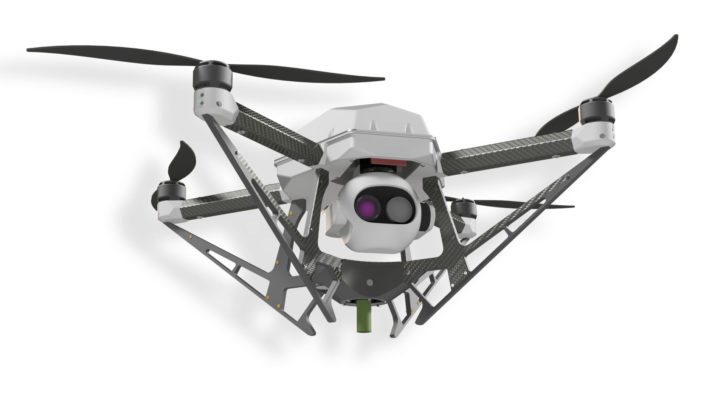 The Hoverfly Livesky Sentry is the solution for extending mobile radio communication in difficult terrain and GPS-denied areas. All the advantages of a tethered drone come into play as it gets its power over the tether line. This enables continued operation for days or even weeks at the specified location. Capable of precise landing in a wide range of weather conditions, the Livesky Sentry is built on open architecture to enable it to use a variety of sensors, radios, and other payloads as it works seamlessly with existing networks. Its Intelligent Automatic Tether System maintains 0.8 pounds of tension and an automatic reel system keeps its position constant relative to the ground station. The durable design meets IP54 as well as MIL-STD-810 standards and it features multi-site control with Smart Command software by Hexagon. The craft also carries a PTZ Hi-Def camera with 10x optical zoom.
The Hoverfly Livesky Sentry is the solution for extending mobile radio communication in difficult terrain and GPS-denied areas. All the advantages of a tethered drone come into play as it gets its power over the tether line. This enables continued operation for days or even weeks at the specified location. Capable of precise landing in a wide range of weather conditions, the Livesky Sentry is built on open architecture to enable it to use a variety of sensors, radios, and other payloads as it works seamlessly with existing networks. Its Intelligent Automatic Tether System maintains 0.8 pounds of tension and an automatic reel system keeps its position constant relative to the ground station. The durable design meets IP54 as well as MIL-STD-810 standards and it features multi-site control with Smart Command software by Hexagon. The craft also carries a PTZ Hi-Def camera with 10x optical zoom.
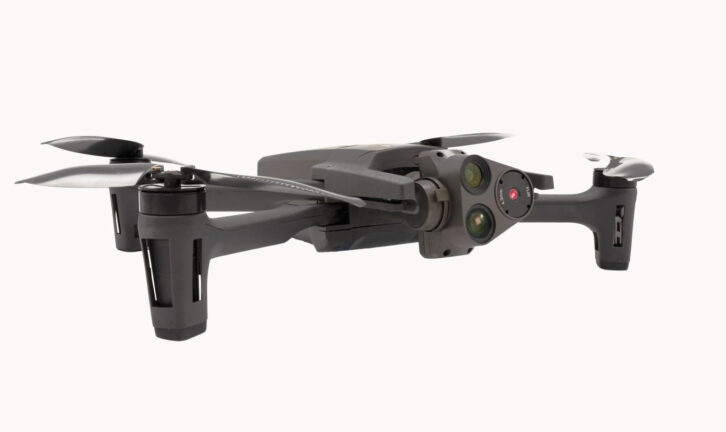 A tiny aerial system cable of big jobs, the Parrot Anafi USA can be unpacked and flight ready in 55 seconds. The IP53 rated aircraft has zero “no flight zone limitation” and it is hand launchable and hand recoverable. The weight is just over a pound and if any of its two-blade propellers needs to be replaced, the job requires no tools. The new propeller just screws on in the opposite direction of prop rotation in flight. ANAFI USA’s vertical camera and ultrasonar are protected from the rain by a collar which shelters both sensors. The vehicle can operate over a wide range of ambient temperatures. The 46W motors power it to about 35mph and this model has a flight time of 32 minutes. The control system operates in the 2.4GHz band on Wi-Fi 802.11a/b/g/n and the video stream can be shared.
A tiny aerial system cable of big jobs, the Parrot Anafi USA can be unpacked and flight ready in 55 seconds. The IP53 rated aircraft has zero “no flight zone limitation” and it is hand launchable and hand recoverable. The weight is just over a pound and if any of its two-blade propellers needs to be replaced, the job requires no tools. The new propeller just screws on in the opposite direction of prop rotation in flight. ANAFI USA’s vertical camera and ultrasonar are protected from the rain by a collar which shelters both sensors. The vehicle can operate over a wide range of ambient temperatures. The 46W motors power it to about 35mph and this model has a flight time of 32 minutes. The control system operates in the 2.4GHz band on Wi-Fi 802.11a/b/g/n and the video stream can be shared.
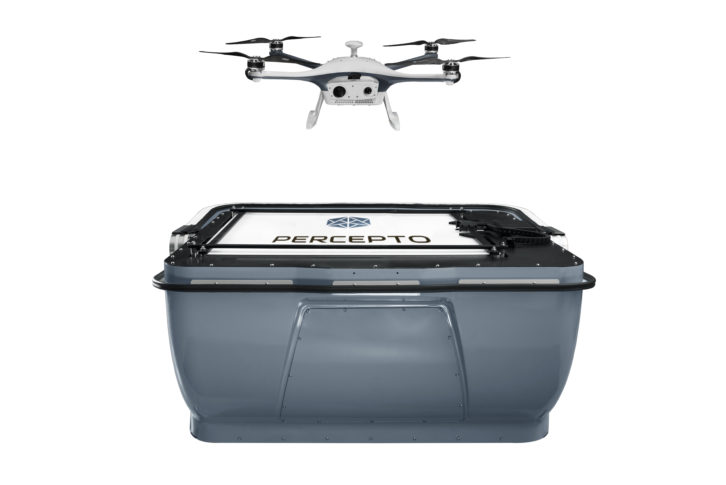 Another field proven UAV model, the Percepto Air Max can operate in a range of conditions after it emerges from its waterproof base with an integrated weather station. The base is also a 24/7 charging box. Fitted with a patented docking and charging system, it allows the drone to be stored in a specific spot where it is protected and ready to fly on remote command without the need for an on-site operator. The Air Max is fitted with 24MP RGB and radiometric thermal cameras but one of the features that makes it a special stand-out is its Optical Gas Imaging (OGI) camera. The vehicle is capable of operation with a wide range of payloads. Percepto’s drones operate on 4G and 5G networks, allowing them to be controlled and monitored from anywhere.
Another field proven UAV model, the Percepto Air Max can operate in a range of conditions after it emerges from its waterproof base with an integrated weather station. The base is also a 24/7 charging box. Fitted with a patented docking and charging system, it allows the drone to be stored in a specific spot where it is protected and ready to fly on remote command without the need for an on-site operator. The Air Max is fitted with 24MP RGB and radiometric thermal cameras but one of the features that makes it a special stand-out is its Optical Gas Imaging (OGI) camera. The vehicle is capable of operation with a wide range of payloads. Percepto’s drones operate on 4G and 5G networks, allowing them to be controlled and monitored from anywhere.
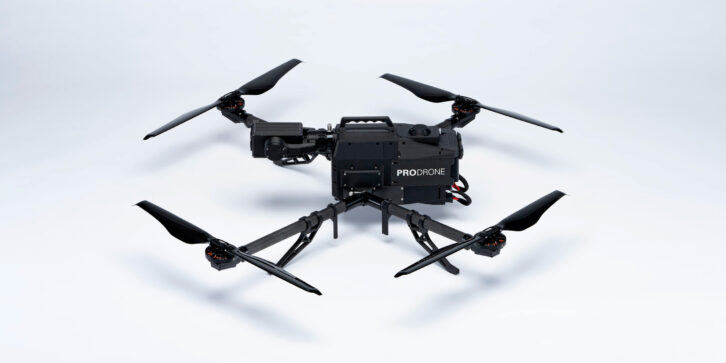 The Prodrone PD4-XA1 is a tough IPX4-rated flyer that is muscular but still light enough to be carried in one hand. Its standard issue camera has a 20x optical zoom in addition to digital zoom capability. Optionally, the video from this camera can be displayed simultaneously with those from infrared imaging. The retractable airframe increases portability, and it can be controlled over a wide area using the LTE radio network. The hot-swappable battery can be replaced while maintaining power. One very special feature is a tethering option for longer, more continuous time on-station. Other features include a parallax camera for detection of obstructions and the drone’s ability to carry a powerful LED floodlight for search and rescue. Each payload unit is interchangeable as an attachment type device and can be used for a wide range of applications.
The Prodrone PD4-XA1 is a tough IPX4-rated flyer that is muscular but still light enough to be carried in one hand. Its standard issue camera has a 20x optical zoom in addition to digital zoom capability. Optionally, the video from this camera can be displayed simultaneously with those from infrared imaging. The retractable airframe increases portability, and it can be controlled over a wide area using the LTE radio network. The hot-swappable battery can be replaced while maintaining power. One very special feature is a tethering option for longer, more continuous time on-station. Other features include a parallax camera for detection of obstructions and the drone’s ability to carry a powerful LED floodlight for search and rescue. Each payload unit is interchangeable as an attachment type device and can be used for a wide range of applications.
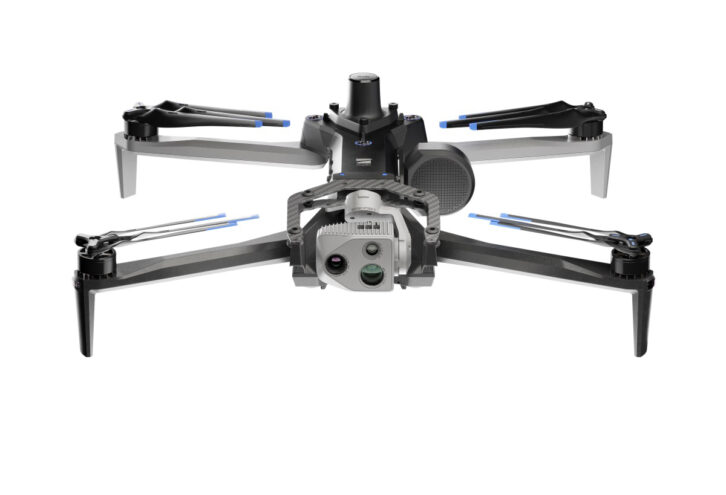 Officially unveiled on September 20th at the company’s Ascend event, the Skydio X10 takes the science of unmanned aerial vehicles to a higher level with the capability of 24/7 automated flight using its NightSense sensor suite. Among the three custom-designed cameras the vehicle can carry are the 48MP zoom camera that can track very small objects in motion, the 50MP wide field of view camera, and a 640×512 Teledyne FLIR Boson+ radiometric thermal camera. Other features on the IP55-rated drone include a replaceable gimbal sensor package and four payload bays. There are multiple communication signal options including a point-to-point link Skydio Connect SL with up to 7.5-mile range, Skydio Connect 5G cellular connection, and Skydio Connect MH. The latter has a six-frequency in-flight selection and AES-256 encryption. This revolutionary little machine can get up to 45mph and stay aloft for as long as 40 minutes.
Officially unveiled on September 20th at the company’s Ascend event, the Skydio X10 takes the science of unmanned aerial vehicles to a higher level with the capability of 24/7 automated flight using its NightSense sensor suite. Among the three custom-designed cameras the vehicle can carry are the 48MP zoom camera that can track very small objects in motion, the 50MP wide field of view camera, and a 640×512 Teledyne FLIR Boson+ radiometric thermal camera. Other features on the IP55-rated drone include a replaceable gimbal sensor package and four payload bays. There are multiple communication signal options including a point-to-point link Skydio Connect SL with up to 7.5-mile range, Skydio Connect 5G cellular connection, and Skydio Connect MH. The latter has a six-frequency in-flight selection and AES-256 encryption. This revolutionary little machine can get up to 45mph and stay aloft for as long as 40 minutes.
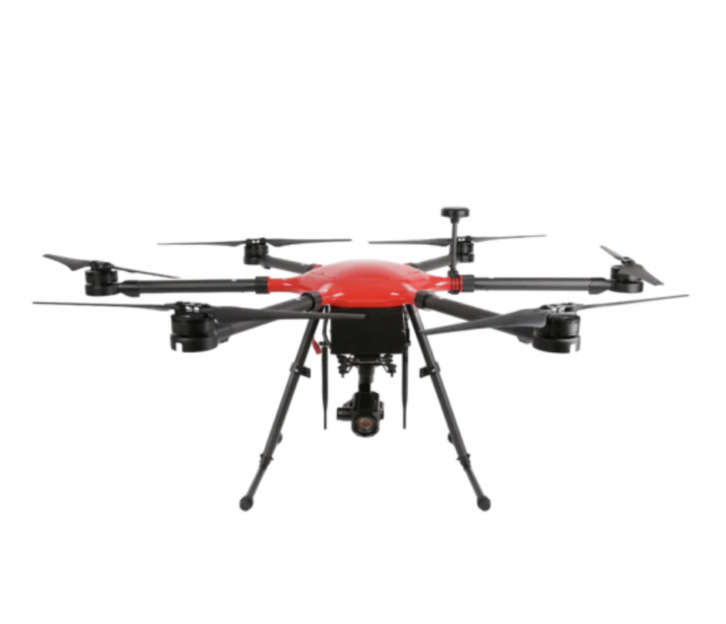 Maximum reliability and staying power form a solid foundation for the Walkera V1100Pro as its foldable, IP43-rated frame flies nearly 6.5 miles from launch and links via dual frequency 2.4GHz and 5.8GHz transmission. Among standard equipment is a 30x optical zoom camera with a recording resolution of 4K/30. Other payloads include a multi-spectral camera, low-light night vision camera, and a thermal infrared camera. Stabilized by its multi-rotor flight control system, the V1100Pro is operated on a display screen with a brightness level of 2000 cd/m² so it is easy to see in bright sunlight. The LiHV 12S 25,000mAh battery keeps the vehicle in the air for up to 63 minutes. Its eight 22.4in. propellers enable it to lift nearly 40lbs. and fly in wind speeds close to 20mph.
Maximum reliability and staying power form a solid foundation for the Walkera V1100Pro as its foldable, IP43-rated frame flies nearly 6.5 miles from launch and links via dual frequency 2.4GHz and 5.8GHz transmission. Among standard equipment is a 30x optical zoom camera with a recording resolution of 4K/30. Other payloads include a multi-spectral camera, low-light night vision camera, and a thermal infrared camera. Stabilized by its multi-rotor flight control system, the V1100Pro is operated on a display screen with a brightness level of 2000 cd/m² so it is easy to see in bright sunlight. The LiHV 12S 25,000mAh battery keeps the vehicle in the air for up to 63 minutes. Its eight 22.4in. propellers enable it to lift nearly 40lbs. and fly in wind speeds close to 20mph.
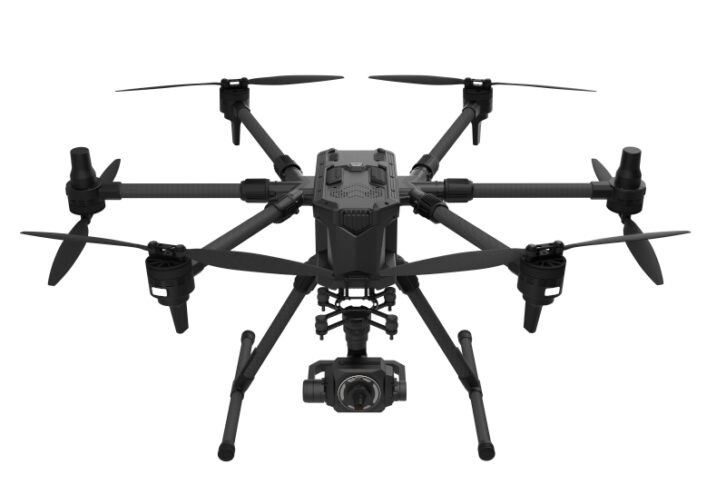 The Yuneec H850 professional level hexacopter features 5-rotor fail-safe, a 3-axis gimbal, hot-swappable cameras with remote controllable camera settings, and a transmission distance of nearly 10 miles. The drone can fly in high wind and carry a powerful searchlight. Hot swappable payloads cut down-time and each has its own SD card for recording data. Up to three payloads can be carried and separately controlled. Future-proofing is designed through external input/output ports. No flight data, images, videos or log files are forwarded to external servers. Reliable operation is maximized with redundant IMUs, compasses and barometers. The Yuneec T-One remote controller features a 7in. built-in 1920×1200 ultra high-definition touchscreen with 1000nit brightness. Its battery life of 5-6 hours and cold start time under 30 seconds represent a significant upgrade from previous controller models.
The Yuneec H850 professional level hexacopter features 5-rotor fail-safe, a 3-axis gimbal, hot-swappable cameras with remote controllable camera settings, and a transmission distance of nearly 10 miles. The drone can fly in high wind and carry a powerful searchlight. Hot swappable payloads cut down-time and each has its own SD card for recording data. Up to three payloads can be carried and separately controlled. Future-proofing is designed through external input/output ports. No flight data, images, videos or log files are forwarded to external servers. Reliable operation is maximized with redundant IMUs, compasses and barometers. The Yuneec T-One remote controller features a 7in. built-in 1920×1200 ultra high-definition touchscreen with 1000nit brightness. Its battery life of 5-6 hours and cold start time under 30 seconds represent a significant upgrade from previous controller models.
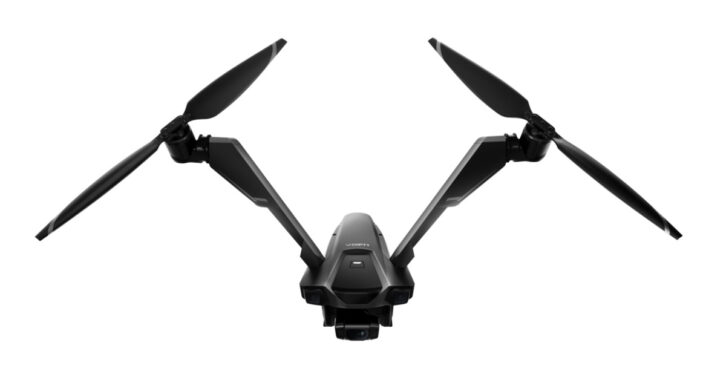 One of the more intriguing drone designs is the Zero Zero Robotics V-Coptr Falcon with its V-shaped dual-rotor propulsion system. Propellers of patented design rotate more slowly to cut down the sound profile and run efficiently. The 3-axis mechanical gimbal allows yaw rotation of +/- 80 degrees and the 1/2.3in. CMOS 12MP camera produces spectacular images for up to 50 minutes of flight time and it does this while avoiding objects through advanced VIO (Visual Inertial Odometry) and a front facing stereo camera. The vehicle can stay with moving subjects using its autofollow capability and pre-programmed flight paths. 2.4GHz band transmission distances over four miles are possible and during flight the V-Coptr Falcon can store JPEG images and 4K mp4 video in an on-board 8GB SD card. Weighing in at just over a pound and a half, the drone is very portable and quick to set up for flight.
One of the more intriguing drone designs is the Zero Zero Robotics V-Coptr Falcon with its V-shaped dual-rotor propulsion system. Propellers of patented design rotate more slowly to cut down the sound profile and run efficiently. The 3-axis mechanical gimbal allows yaw rotation of +/- 80 degrees and the 1/2.3in. CMOS 12MP camera produces spectacular images for up to 50 minutes of flight time and it does this while avoiding objects through advanced VIO (Visual Inertial Odometry) and a front facing stereo camera. The vehicle can stay with moving subjects using its autofollow capability and pre-programmed flight paths. 2.4GHz band transmission distances over four miles are possible and during flight the V-Coptr Falcon can store JPEG images and 4K mp4 video in an on-board 8GB SD card. Weighing in at just over a pound and a half, the drone is very portable and quick to set up for flight.


